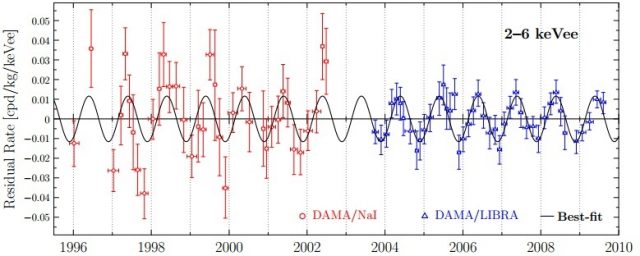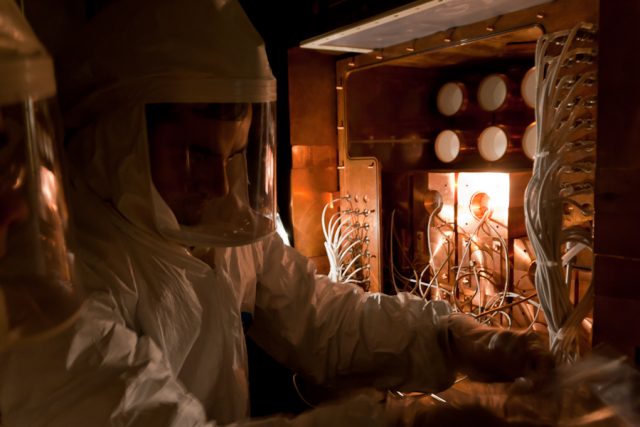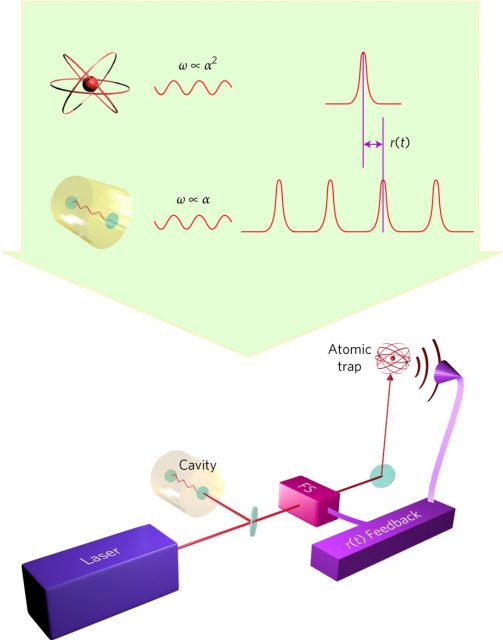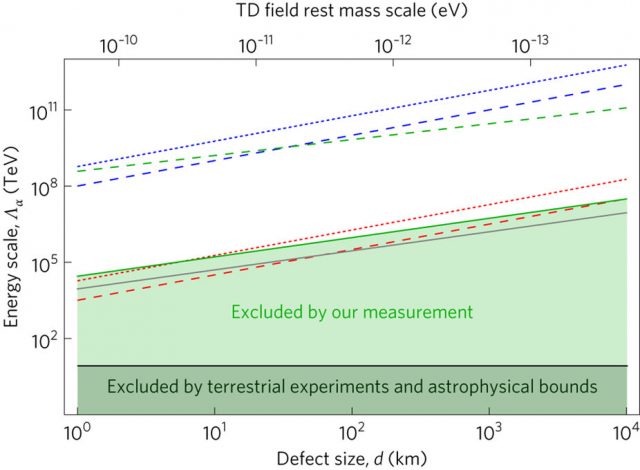Testing alternative Dark Matter hypotesis with a clock.
The direct search for dark matter has been a thriving experimental field since a couple of decades, and a new and promising experimental approach has been recently developed and tested: the use of an atomic clock inner mechanics. This whole new idea seems to be relatively cheap since no huge technological development is needed, and relatively fast, in contrast with the complicated long term low background experiments that constitutes the majority of direct detection dark matter search. Elegantly simple, powerful and relatively easy. How does it works?
But first, we should summarize some dark matter concepts before getting ourselves dirty with technical details. As it’s known since some decades, Dark Matter is matter that produces gravitation but does not interact with anything via electromagnetic force (supposedly it can only interact via weak force), so it does not shine back when illuminated, hence the “dark” in dark matter. The most well founded theory about dark matter implies some kind of “spherical halo” structure of dark matter around every galactic center, and the Earth should be moving across milky way’s own halo. And then, some kind of dark matter “wind” should be hitting the Earth. This “wind” should fluctuate slightly from a number of reasons, one being the earth’s orbit around the sun, implying that at some points of the year the Earth should be moving in favor or against this dark matter “wind”.

There are some experiments trying to exploit this effect, and the most famous (or in-famous) out there is the DAMA-LIBRA collaboration, claiming to see an one year period modulation on their calorimeter signal, thus confirming the existence of dark matter, since an astonishing nineteen years 1. In this experiment the Dark Matter particles should “hit” the detector at different speeds depending on the time of the year, producing the year modulation. Since the result has not been reproduced by other similar approaches, a great deal of healthy skepticism is casted against the DAMA-LIBRA collaboration, but there is an ongoing effort to replicate the experiment in Australia, in the southern hemisphere, that would confirm or refute the DAMA/LIBRA claims, as soon as this year! 2. Other approaches such as XENON100 focus on precisely measuring the characteristics of an impact of dark matter in their detectors, mostly filled with Xenon, a noble gas (in liquid form here) that scintillates (shines) when an ionizing particle travels trough it. Dark Matter is not ionizing, but it can “hit” a Xenon atom via weak force interaction, transferring to it its energy, and the recoiled Xenon atom becomes the ionizing particle, producing detectable light. So far, no single experiment has been able to positively detect any Dark Matter particle, but since any experiment is only sensitive to a particular range of hypothetical Dark Matter energies, there is a lot of room for improvement sensing the huge energy regions that remain unexplored so far.


Here we have a new and interesting approach, in which Dark Matter would not be a particle but a region of the space with special characteristics, as an alternative hypothesis to the WIMP one (Weakly Interacting Massive Particle). It turns out that some of the Dark Matter theoretical models predicts that the Standard model parameters should vary slightly in the presence of Dark Matter, and this can be exploited with an atomic clock design. Dark Matter in this scenario would consist in something called a “topological defect”, a slight variation on the quantum field created at the birth of the universe, containing energy and therefore gravitating. In this scenario Dark Matter would not be a particle by itself. In the presence of that defect, the fine structure constant should be slightly different than in one without it. An atomic transition’s frequency depends on that constant, and guess which devices measures atomic transitions with spectacular precisions. You guessed right, atomic clocks!
There is a number of different atomic clock designs, but we’ll focus on the optical ones. Summarizing, a laser finely tuned to match the frequency of a particular atomic transition is fired upon a gas of prepared atoms, exciting them. When those atoms go back to their original state a photon is emitted, having it always almost the same frequency if the atom is chosen right. The constant wave flow at a very precise frequency is interpreted as ticks on a clock. Since the emitting frequency is almost always the same by the laws of nature, by merely counting cycles one can measure time. The precision of those devices is so high that, commonly, an uncertainty of only one second is expected after an astonishing 15 billion years, the age of the universe!
The thing is that the frequency of that particular transition depends upon the fine structure constant as follows, in the presence of Dark Matter, δα/α = φ2/Λα2; where φ2 is the Dark Matter field, and Λα2 is the energy scale, a function of the coupling between the standard model and Dark Matter. So, in simple terms, if this is changed, the fine structure constant should change. If Dark Matter is present, the fine structure constant changes. And the frequency of an atomic transition is proportional to the square of the fine structure constant, so one should measure slightly different frequencies in the presence of atomic transitions.
Moreover, an interesting design choice enables the measurement of the differences by itself by splitting part of the laser beam into an optical cavity with two mirrors facing each other. The surviving frequencies would be dependent on the distance from one mirror to another, and also the fine structure constant in a proportional way. So if we are sure that the cavity is perfectly still and the mirrors does not move we can assert that:
Fcavity ∝ α
Ftransition∝ α
And by measuring both frequencies and plotting their difference over time one should, if Dark Matter is present, see an increment or decrement over time since each device (the cavity and the gas) reacts to Dark Matter in different ways as the Earth traverses a Dark Matter object.

The design also includes a frequency shifter for the laser, a device used to fine tune the laser’s frequency and lock it to the atomic transition through a feedback loop. The amount of “shifting” needed in frequency is a function of the atomic frequency amplitude, since when more precisely we fire the laser to the transition frequency better are our odds of provoking an atomic transition, so, the better we tune our laser, the strongest is our signal. This frequency shifter, commonly used in atomic clocks, can work as our sensor for fine structure constant changes if compared to the frequency of the optical cavity. To avoid near sources of noise, a second feedback loop separated by 10 meters is used, splitting the laser beam between both feedback loops. By plotting the correlation between both feedback loops one can eliminate all local background, ideally leaving only the Dark Matter effect.

But, as is becoming usual in this topic, it seems that nature is playing hide and seek with us and a big amount of nothingness was sensed by the experiment 3. No Dark Matter was detected, and the change in the fine structure constant was measured to be at least lower than 5×10^-15 (yes, those devices are extremely precise). But this is not necessarily a bad result. The experiment was proposed as a “pathfinder” of this practical approach. There is a great room of improvement ahead. Also, the previous boundaries of what can and cannot be Dark Matter have been stretched. The experiment was able to “look” into a previously unexplored area of energies, and by confirming that Dark Matter does not have those characteristics theoretical physicists have more data to work trying to model this unknown particle (or particles). And also experimental physicists, at the light of this alternative technologically reasonable approach, can think in more creative ways of exploiting the effects of Dark Matter in everything else. Let’s hope that, some day, maybe in our near future, this riddle is solved once for all. I cannot wait to see it.
References
- R. Bernabei; et al. (2013). “Final model independent result of DAMA/LIBRA-phase1”. European Physical Journal C. 73 (12): 2648, doi: 10.1140/epjc/s10052-013-2648-7. ↩
- Phillip Urquijo. (2016). The Southern Hemisphere Hunt for Dark Matter at the Stawell Underground Physics Laboratory, arXiv:1605.03299 ↩
- P. Wcislo et al. (2016). Experimental constraint on dark matter detection with optical atomic clocks. Nature Astronomy 1, 0009 , doi:10.1038/s41550-016-0009 ↩
1 comment
[…] La materia es uno de los misterios más interesantes de nuestra comprensión del universo. Y puede investigarse usando un reloj. Víctor Marín en Testing alternative Dark Matter hypotesis with a clock. […]